My comments today on last week's Broward County Transit Summit -held at the Broward Convention Center at Port Everglades- follow the great spot-on analysis by the Herald's Larry Lebowitz in Monday's paper, and the one in the Sun-Sentinel -a very cursory review with numerical mistakes- by Michael Turnbell and Scott Wyman.
_________________________________________________
http://www.miamiherald.com/news/miami_dade/story/279741.html
Miami Herald
Broward transit stuck in low gear
October 22, 2007
by Larry Lebowitz
The scene must have seemed all too familiar to the 200 transportation professionals, elected officials and civic leaders who gathered with a smattering of regular folks last week at the Broward County Convention Center.
They assembled for the latest ''summit'' to ponder Broward's mass transit future -- or, more accurately, the lack thereof -- for a community of 1.7 million residents today and another 700,000 expected by 2030.
Outgoing county Mayor Josephus Eggelletion, who campaigned against last year's penny sales tax for transportation, asked the assembly to break into small brainstorming groups.
They yielded many substantive, if all too predictable, short- and long-term solutions. Many mirrored the big wish list from the sales-tax campaign that only garnered 38 percent of the vote last fall:
• Develop passenger service on the Florida East Coast rail corridor.
• Buy more buses -- and run them more frequently -- to attract more riders.
• Improve service on the east-west corridors that feed into the burgeoning north-south corridors on U.S. 441, U.S. 1 and State Road A1A.
• Synchronize traffic signals (which really will help single-occupant vehicles more than transit, but we'll let that slide because, frankly, they're right).
Plenty of common sense was flowing in the room. Several tables wanted to link countywide or regional land-use plans with future transit needs. Others wanted to make it easier for municipalities to widen sidewalks and erect bus shelters to reward current transit customers and attract new ones.
But ultimately what they were really clamoring for were two vital things: leadership and money.
LEADER NEEDED
Public transportation in Broward, they said, needs a champion, a political leader willing to look beyond the boundaries of his own district and with a vision that extends far beyond the next two- to four-year election cycle.
If that champion actually exists, he or she needs to build a consensus across a thicket of diverse economic, civic, age, ethnic and municipal boundaries, making a case for the community to tax itself -- and in the process, qualify for billions of matching federal and state dollars needed to build and run a transit system.
''It was déjà vu all over again,'' Jim Cummings, the Fort Lauderdale construction magnate who led the unsuccessful sales-tax campaign, said after last week's summit. ``Everybody pretty much said the same thing: We need leadership. I hope that commissioners realize all these people were talking about them.''
Broward's population is larger than many major U.S. urban areas. Its roads are already at or beyond capacity and there is very little vacant land remaining between the ocean and the Everglades. The inevitable result: more motorists on virtually the same roads.
And for a county of its size, Broward is running a relatively tiny bus operation.
Consider that Broward County Transit serves a community with roughly 100,000 more residents than Tri-Met, the three-county authority that serves greater Portland, Ore., and 100,000 fewer than the King County Metro serving greater Seattle.
Broward County Transit: 240 buses, zero trains, 900 employees.
Tri-Met: 623 buses, 87 trains -- and rapidly expanding, 2,650 employees.
King County Metro: 1,335 buses and trolleys, 4,300 employees.
Sure, they're vastly different places. Portland and Seattle came of age before World War II -- when downtowns were the economic, cultural and commercial hubs of their regions.
Broward, by comparison, is the epitome of the post-WWII car-centric uber-suburb still searching for its own identity. Jobs, shopping, entertainment and cultural centers are scattered across the landscape from Deerfield Beach to Hallandale Beach in the east and from Coral Springs to Miramar out west.
BUILD CONSENSUS
Broward County Transit Director Chris Walton is hoping that last week's summit will spawn dozens of continuing community conversations over the next 18 months, building consensus from the ground up, for a concrete list of projects that a sales tax would pay for. The next forum is set for Nov. 13 in Pembroke Pines.
''Without a dedicated funding source, we're not going anywhere,'' Walton said.
Don't look to the incoming mayor, Commissioner Lois Wexler, to champion a transit tax. Wexler made it very clear: She isn't going to accept, much less campaign for, a plan that doesn't have complete community buy-in.
Even if it does get to the ballot, it probably won't be approved, given the current climate. Some high-growth Sun Belt communities need three or four tries before congestion gets so bad that wary voters are finally willing to tax themselves.
Homeowners clamoring for property-tax and insurance relief probably aren't in the mood to further tax themselves.
And while the region is getting younger, a large segment of Broward politics is still dominated by the elderly and condo associations. How do you convince seniors who came here for sun, fun and cheap living in their fixed-income golden years to vote for a tax that probably won't bear much real fruit while they're still around?
Which means there may be more ''déjà vu all over again'' transportation summits in Broward's future.
______________________________________________________
South Florida Sun-Sentinel
SUMMIT GATHERS MASS TRANSIT IDEAS
October 17, 2007
by Michael Turnbell and Scott Wyman
Fort Lauderdale
What should be done to improve mass transit in Broward County? About 100 elected officials, planners, consultants and residents asked themselves that question Tuesday at Broward's first transit summit.
Buses and trains need to run more often. They need to be safe and reliable. And they need to go where people live and work.
Mass transit plans must be forward-thinking but reflect what residents and users want, not political agendas.
"It ought to be about what the community wants to achieve," said County Mayor Josephus Eggelletion. "People are smart enough to tell us what they want."
With a population of about 1.8 million, Broward's mass transit system lags behind comparable metro areas. Broward County Transit has 240 buses vs. Seattle's King County Metro, which has more than 1,300 buses. Dallas has 604 buses and 103 rail cars. Portland, Ore., has 623 buses and 87 rail cars. Miami-Dade County has a fleet of 751 buses and 104 rail cars.
What do the other metro areas have that Broward doesn't? A dedicated source of money such as a sales tax that pays for operations, said William Millar, executive director of the American Public Transportation Association.
Without it, Broward's system has little chance of growing or attracting new riders.
"You can have the best plan in the world, but if the money isn't there to implement it, it will be all for naught," Millar said.
County officials said future transit summit meetings will be in the evening when more people can attend. The next summit is planned for Nov. 13 in Pembroke Pines. Another will be held Jan. 24 in Fort Lauderdale.
__________________________________________________________________
I wanted to let you know that I'm in the process of finishing a letter to incoming Broward County lower-case mayor Lois Wexler.
Wexler kindly referred to me at last week's Broward County Transit Summit as the 'gentleman in the back' -I've been called worse!- in the beginning of her closing comments, after I'd earlier taken the microphone to speak for my table of seven participants, and publicly noted for all the attendees that one of the biggest longstanding problems with the County is their lack of accountability with the public.
That's perhaps best personified by the fact that, despite my being a person who's serious about public affairs, I didn't find out about the summit until the previous Saturday's Herald, in a story with no byline on page 3 of the Broward/Local section. (See below)
Frankly, I could've zipped right past it if I wasn't quite so attentive, and been none the wiser.
And no thanks to the Sun-Sentinel for not even bothering to write about it until the day before the event, albeit on the front page, above the fold.
Honestly, who needs to sabotage an event's turnout when the people throwing it do such a good job of that themself?
Frankly, because of my own past and wide-array of media friends around the country, print and electronic, I've never been a big fan of 'killing the messenger,' yet the 'awareness' problem I cited was never adequately addressed by either Comm. Wexler or Comm. Eggelletion, the hosts as it were.
The letter I'm writing will be much more critical and more specific than the handful of things of things that I mentiuoned in my email to Commissioner Gunzburger last week, which I sent to you as a bcc on the chance that you attended the summit.
I also hope to have some illuminating photos of the examples I cite, since they're self-evident to even the state/county/muncipalities most ardent transit defenders.
As you'd expect, given what I wrote last week, the examples cited are mostly in Hollywood and Hallandale Beach, but I've seen identical examples in downtown FTL & Miami, on Biscayne Blvd and on Miami Beach, it's just that they're more personally galling to me since I see them all the time because of where I live and recreate.
Believe me when I tell you, I have a specific example of intergovernmental inertia & incompetency that will have all the folks in South Florida who care about transit and transportation scratching their heads, since it will hold a mirror up to a situation that the county and its army of apologists has allowed to exist for years, and for which no good excuses exist.
As it happens, I spoke to dozens of people at the summit last week about this particular topic, and got the same dazed look/shoulder shrug that's become endemic in public circles down here for the past 30 years when the public finds out -again- about how abysmally low the level of personal and professional accountability is here
It's roughly on the same level of counter-intuitive brainpower that caused FIU to say no to having the Metrorail come towards campus last year.
Since last Tuesday, I double-checked some of last year's posts at CriticalMiami to be sure the devastating article Larry Lebowitz wrote about the FIU debacle matched my recollection of it, and I was pleased that their posts confirmed it.
Once I've got the letter to Wexler and her colleagues finished -with lots of cc's & bcc's to other very interested parties in South Florida & Tallahasse- I'll be posting it to my blog so that others can publicly ponder what the real level of desire is to solve genuine transit problems, and what's so embarrassing because of it's longstanding nature, that some would prefer to imagine that it doesn't exist
______________________________________________
Miami Herald
FORT LAUDERDALE: Public invited to county's transit summit
October 13, 2007
Finding ways to alleviate Broward County's traffic congestion will be the topic of a transit summit on Tuesday. The summit will be from 1 to 4:30 p.m. at the Broward County Convention Center, 1950 Eisenhower Blvd., Fort Lauderdale. Parking is free and public participation is encouraged.
"This is the first in a series of public meetings that will take place countywide over the next two years," Broward County Mayor Josephus Eggelletion Jr. said in a press release. "We will engage local, regional and state officials, business and community leaders, residents and transit riders in a discussion that will eventually lead to a master public transportation plan."
William Millar, president of the American Public Transportation Association, will be the keynote speaker, providing a national perspective on public transportation.
Presentations will include information from the Metropolitan Planning Organization, the Florida Department of Transportation, Broward County Transit, Miami-Dade Transit, Palm Tran, South Florida Regional Transit Authority (Tri-Rail), and the Regional Planning Councils. Roundtable discussions will provide a forum for attendees to voice their concerns, ideas and recommendations.
On Tuesday, the County Commission will not meet for its regular session and will conduct a joint workshop with the Metropolitan Planning Organization about transportation issues at 10 a.m. at the Convention Center.
For more information, call 954-357-8355.
______________________________
http://www.sun-sentinel.com/news/local/broward/sfl-flbsummit1015nboct15,0,6102052.story
South Florida Sun-Sentinel
Broward asks public for suggestions on fixing mass transit
By Michael Turnbell
October 15, 2007
What do you think of mass transit in Broward County? What would you do to fix it? And are you willing to pay for it?
Billions could be spent putting commuter trains on the Florida East Coast Railway through the county's coastal downtowns, building an east-west light rail connecting the western suburbs to downtown Fort Lauderdale and the airport, and creating a countywide network of rapid transit bus routes with limited stops.
The reality is that none of it will get built without a consensus or huge financial commitment from county taxpayers.
With those questions in mind, Broward County officials are hosting a transit summit Tuesday to address what should be done.
The summit will be the first in a series of countywide meetings over the next two years with residents, business leaders, elected officials and transit riders to come up with a master public transportation plan.
While mass transit will be the focus, County Mayor Josephus Eggelletion said the summit will be open to any suggestion about improving the way commuters get around the county, such as synchronizing traffic signals. The meetings also would be used to educate residents on the complexities of transportation funding and just how bad congestion will get if nothing is done.
"We, as elected officials, might have our own ideas about what should be in the plan but unless the general public buys into it, it won't happen," Eggelletion said.
The county's timing is crucial. In 2009, Congress will begin reauthorizing the next six-year transportation spending bill.
The federal government currently pays up to 50 percent of the construction cost for new mass transit projects. But even to get in line for money, state and local governments must have a dedicated funding source in place to pay for the other half as well as cover operating costs. Local governments also must demonstrate to federal officials that a project will attract enough riders to justify the expense of building it.
Broward already has a long-range transportation plan that prioritizes projects to be built over the next 20 years. The plan, which is updated every three years, is approved by the Metropolitan Planning Organization, a 19-member voting body that includes county commissioners, city representatives and the Broward School Board.
The group meets monthly, but few from the public attend.
Some mass transit projects have struggled to win acceptance from the community.
In November 2004, the organization approved the route for a proposed east-west light rail that would send trains along Northwest 136th Avenue, Interstate 595, State Road 7, Broward Boulevard, Andrews Avenue and U.S. 1.
But Eggelletion, who is a member of the planning group, has been sharply critical of the idea. He said residents along the route don't want it, either.
State officials already have shifted the western leg of the line to run through a business park instead of along 136th Avenue, because of residents' opposition.
In November 2006, Broward County voters overwhelmingly rejected increasing the sales tax from 6 to 7 percent to improve mass transit.
Voters didn't buy into the transportation tax after county commissioners said they wouldn't be bound to honor the list of transit projects they endorsed several weeks before the election.
Key business groups lobbied heavily for the sales tax increase. But the campaign lacked widespread public support from residents and neighborhood groups.
Eggelletion said many people in his central Broward district, whom he described as the most likely in the county to use mass transit, didn't know the issue was on the ballot.
"That's where the past initiative failed," Eggelletion said. "It was really well-intended, but it failed to get people involved. It has to be more than just the business community."
Michael Turnbell can be reached at mturnbell@sun-sentinel.com, 954-356-4155or 561-243-6155.
Subscribe to:
Post Comments (Atom)
In the Heart of a Great Country, Beats the Soul of Hoosier Nation
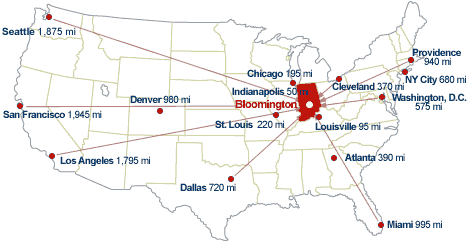
"In the Heart of a Great Country, Beats the Soul of Hoosier Nation." -South Beach Hoosier, 2007
#IUBB, #bannersix
The South Florida I Grew Up In
Excerpts from Joan Didion's Miami, 1987, Simon & Schuster:
In the continuing opera still called, even by Cubans who have now lived the largest part of their lives in this country, el exilo, the exile, meetings at private homes in Miami Beach are seen to have consequences. The actions of individuals are seen to affect events directly. Revolutions and counter-revolutions are framed in the private sector, and the state security apparatus exists exclusively to be enlisted by one or another private player. That this particular political style, indigenous to the Caribbean and to Central America, has now been naturalized in the United States is one reason why, on the flat coastal swamps of South Florida, where the palmettos once blew over the detritus of a dozen failed booms and the hotels were boarded up six months a year, there has evolved since the early New Year's morning in 1959 when Fulgencio Batista flew for the last time out of Havana a settlement of considerable interest, not exactly an American city as American cities have until recently been understood but a tropical capital: long on rumor, short on memory, overbuilt on the chimera of runaway money and referring not to New York or Boston or Los Angeles or Atlanta but to Caracas and Mexico, to Havana and to Bogota and to Paris and Madrid. Of American cities Miami has since 1959 connected only to Washington, which is the peculiarity of both places, and increasingly the warp...
"The general wildness, the eternal labyrinths of waters and marshes, interlocked and apparently neverending; the whole surrounded by interminable swamps... Here I am then in the Floridas, thought I," John James Audobon wrote to the editor of The Monthly American Journal of Geology and Natural Science during the course of an 1831 foray in the territory then still called the Floridas. The place came first, and to touch down there is to begin to understand why at least six administations now have found South Florida so fecund a colony. I never passed through security for a flight to Miami without experiencing a certain weightlessness, the heightened wariness of having left the developed world for a more fluid atmosphere, one in which the native distrust of extreme possibilities that tended to ground the temperate United States in an obeisance to democratic institutions seemed rooted, if at all, only shallowly.
At the gate for such flights the preferred language was already Spanish. Delays were explained by weather in Panama. The very names of the scheduled destinations suggested a world in which many evangelical inclinations had historically been accomodated, many yearnings toward empire indulged...
In this mood Miami seemed not a city at all but a tale, a romance of the tropics, a kind of waking dream in which any possibility could and would be accomodated...
Hallandale Beach Blog
http://www.hallandalebeachblog.blogspot.com/
Hallandale Beach Blog is where I try to inject or otherwise superimpose a degree of accountability, transparency and much-needed insight onto local Broward County government and public policy issues, which I feel is sorely lacking in local media now, despite all the technological advances that have taken place since I grew-up in South Florida in the 1970's. On this blog, I concentrate my energy, enthusiasm, anger, disdain and laser-like attention primarily on the coastal cities of Aventura, Hollywood and Hallandale Beach.
IF you lived in this part of South Florida, you'd ALREADY be in stultifying traffic, be paying higher-than-necessary taxes, and be continually musing about the chronic lack of any real accountability or transparency among not only elected govt. officials, but also of City, County and State employees as well. Collectively, with a few rare exceptions, they couldn't be farther from the sort of strong results-oriented, work-ethic mentality that citizens here deserve and are paying for.
This is particularly true in the town I live in, the City of Hallandale Beach, just north of Aventura and south of Hollywood. There, the Perfect Storm of years of apathy, incompetency and cronyism are all too readily apparent.
It's a city with tremendous potential because of its terrific location and weather, yet its citizens have become numb to its outrages and screw-ups after years of the worst kind of chronic mismanagement and lack of foresight. On a daily basis, they wake up and see the same old problems again that have never being adequately resolved by the city in a logical and responsible fashion. Instead the city government either closes their eyes and hopes you'll forget the problem, or kicks them -once again- further down the road.
I used to ask myself, and not at all rhetorically, "Where are all the enterprising young reporters who want to show through their own hard work and enterprise, what REAL investigative reporting can produce?"
Hearing no response, I decided to start a blog that could do some of these things, taking the p.o.v. of a reasonable-but-skeptical person seeing the situation for the first time.
Someone who wanted questions answered in a honest and forthright fashion that citizens have the right to expect.
Hallandale Beach Blog intends to be a catalyst for positive change. http://www.hallandalebeachblog.blogspot.com/
http://www.hallandalebeachblog.blogspot.com/
Hallandale Beach Blog is where I try to inject or otherwise superimpose a degree of accountability, transparency and much-needed insight onto local Broward County government and public policy issues, which I feel is sorely lacking in local media now, despite all the technological advances that have taken place since I grew-up in South Florida in the 1970's. On this blog, I concentrate my energy, enthusiasm, anger, disdain and laser-like attention primarily on the coastal cities of Aventura, Hollywood and Hallandale Beach.
IF you lived in this part of South Florida, you'd ALREADY be in stultifying traffic, be paying higher-than-necessary taxes, and be continually musing about the chronic lack of any real accountability or transparency among not only elected govt. officials, but also of City, County and State employees as well. Collectively, with a few rare exceptions, they couldn't be farther from the sort of strong results-oriented, work-ethic mentality that citizens here deserve and are paying for.
This is particularly true in the town I live in, the City of Hallandale Beach, just north of Aventura and south of Hollywood. There, the Perfect Storm of years of apathy, incompetency and cronyism are all too readily apparent.
Sadly for its residents, Hallandale Beach is where even the easily-solved or entirely predictable quality-of-life problems are left to fester for YEARS on end, because of myopia, lack of common sense and the unsatisfactory management and coordination of resources and personnel.
It's a city with tremendous potential because of its terrific location and weather, yet its citizens have become numb to its outrages and screw-ups after years of the worst kind of chronic mismanagement and lack of foresight. On a daily basis, they wake up and see the same old problems again that have never being adequately resolved by the city in a logical and responsible fashion. Instead the city government either closes their eyes and hopes you'll forget the problem, or kicks them -once again- further down the road.
I used to ask myself, and not at all rhetorically, "Where are all the enterprising young reporters who want to show through their own hard work and enterprise, what REAL investigative reporting can produce?"
Hearing no response, I decided to start a blog that could do some of these things, taking the p.o.v. of a reasonable-but-skeptical person seeing the situation for the first time.
Someone who wanted questions answered in a honest and forthright fashion that citizens have the right to expect.
Hallandale Beach Blog intends to be a catalyst for positive change. http://www.hallandalebeachblog.blogspot.com/
Hallandale Beach's iconic beachball-colored Water Tower, between beach and A1A/South Ocean Drive
Hollywood in Cartoons, The New Yorker

"Gentlemen, I am happy to announce that as of today we are closing down our Washington news bureau and moving the entire operation to L.A."
Hollywood in Cartoons, The New Yorker
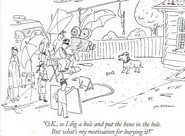
"O.K., so I dig a hole and put the bone in the hole. But what's my motivation for burying it?"
Hollywood in cartoons, 10-21-06 Non-Sequitur by Wiley, www-NON-SEQUITUR.COM

The Magic of Hollywood: A motion has been put forth that we should seek to create rather than imitate. All in favor of killing this silly notion, nod in mindless agreement...
Miami Dolphins
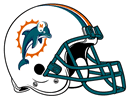
South Beach Hoosier's first Dolphin game at the Orange Bowl came in Dec. 1970, aged 9, a 45-3 win over Buffalo that propelled them into their first ever playoff appearance.
Sebastian the Ibis, the Spirited Mascot of the University of Miami Hurricanes

Before going to my first U-M game at the Orange Bowl in 1972, a friend's father often would bring me home an extra 'Canes game program. That's how I came to have the Alabama at U-M game program from Nov. 16, 1968, which was the first nationally-televised college football night game in color. (A 14-6 loss to the Crimson Tide.) After that first ballgame against Tulane, as l often did for Dolphin games if my father wasn't going, I'd get dropped off at the Levitz parking lot near the 836 & I-95 Cloverleaf in NMB, and catch a Dade County Park & Ride bus, going straight to the Orange Bowl. Onboard, I'd get next to the window and listen to WIOD's pre-game show on my Radio Shack transistor radio. A few times, I was just about the only person onboard besides the bus driver, which was alright by me. Once at the Orange Bowl, if I didn't already have a ticket, I'd buy a game program for myself and one or two for friends or teachers before heading to the ticket window, since you usually couldn't find a program vendor once inside. I probaly had a friend or my father with me for just under 40% of the U-M games I ever went to, but you have to remember that the team, though blessed with several talented players, like Chuck Foreman and Burgess Owens, was just so-so to average at best, and the games were usually played on Friday nights, so it wasn't exactly high on everyone's list of things to do. Depending upon the opponent, if I was alone, I'd often have entire areas of the Orange Bowl to myself. (Wish I had photos of that now!) For instance, I had a good portion of the East (open) End Zone to myself against Oklahoma in the mid-70's, when the Boomer Schooner and the Schooner Crew went out on the field after an Oklahoma TD, and the Schooner received an unsportsmanlike conduct penalty from the refs, as would happen years later in an Orangle Bowl Classic game. (Against FSU?) I was there for the wins and losses under Pete Elliott, Carl Selmer & Lou Saban, and the huge on-field fight in '73 when under eventual national champion Notre Dame (under Ara Parseghian), they called a time-out with less than a minute to go, and already up 37-0. Their rationale? To score another TD and impress the AP football writers; final score 44-0. Well, they got their wish and beat Alabama 24-23 for the title at the Sugar Bowl. A year later, thanks to my Mom's boss, she and I saw Ara's last game as head coach of the Irish in the Orange Bowl Game from the East End Zone -in front of the Alabama cheerleaders!!!- in an exciting 13-11 Notre Dame win over Alabama and Bear Bryant, a rematch of the '73 national title game. I was also present for the U-M's huge 20-15 win under Pete Elliott against Darrel Royal's Texas Longhorns, the week Sports Illustrated's College Football preview issue came out with Texas on the cover, below. I was also present for lots of wins against schools called College of the Pacific, UNLV and Cal-Poly San Luis Obsispo, which I'd then never heard of before.
Miami Dolphins Cheerleaders, April 28, 2007

Photo by Mario J. Bermudez. April 28, 2007 at Dolphins NFL Draft Party at Dolphin HQ, Davie, FL
Of cheerleaders past and present
Given South Florida's unique version of the melting pot -con salsa- demographics and mindset, these women in the photo above are surely what most South Floridians would consider attractive women. But for this observer, who's spent hours & hours at IU cheerleader tryouts and who has known dozens of cheerleaders -and wannabes- in North Miami Beach, Bloomington, Evanston and Washington, D.C., the whole time I was watching these members of the Dolphins' squad perform, I couldn't help but compare them and their routines to those of some IU friends of mine who ALWAYS showed true Hoosier spirit & enthusiasm.
Sitting at my table right near the stage and still later, while watching the long lines of Dolphin fans of all ages waiting to snap photos of themselves with the cheerleaders, I couldn't help but think about those friends who always left me and other Hoosier fans feeling positive & optimistic.
Was there anyone I saw in Davie who possessed these valuable intangibles: the dancing precision of IU Red Stepper -and Captain- Gail Amster, my talented and spirited Phi Beta Kappa pal from Deerfield (IL), who always sat next to me in our Telecom. classes as we took turns entertaining the other; the ebullient spirit & energy of two Hoosier cheerleaders -and captains- from Bloomington, Wendy (Mulholland) Moyle & Sara Cox; the hypnotic, Midwestern, girl-next-door sexiness of Hoosier cheerleader Julie Bymaster, from Brownsburg; or, the adorable Southern girl-next-door appeal of former Hoosier Pom squader Jennifer Grimes, of Louisville, always such a clear distraction while sitting underneath the basket?
Nope, not that I could see. But then they were VERY tough acts to follow!!!
And that's not to mention my talented & spirited friends like Denise Andrews of Portage, Jody Kosanovich of Hammond & Linda Ahlbrand of Chesterton, all of whom were dynamic cheerleaders -and captains- at very large Hoosier high schools that were always in the championship mix, with Denise's team winning the Ind. football championship her senior year when she was captain -just like in a movie. That Denise, Jody & Linda all lived on the same dorm floor, just three stories above me at Briscoe Quad our freshman year, was one of the greatest coincidences -and strokes of luck for me!- that I could've ever hoped for.
You could hardly ask for better ambassadors of IU than THESE very smart, sweet and talented women. In a future SBH post, I'll tell the story of one of the greatest Hoosiers I ever met, the aforementioned Wendy Mulholland, the Bloomington-born captain and emotional heart of the great early '80's IU cheerleading squads, and the daughter of Jack Mulholland, IU's former longtime Treasurer. The acorn doesn't fall far from a tree built on a foundation of integrity & community service!
(After he retired, Mr. Mulholland was the first executive director of the Community Foundation of Bloomington and Monroe County. I used to joke with Wendy that her dad's name was the one that was permanently affixed to the bottom of my work-study checks for years, while I worked at the Dept. of Political Science's Library, first, at the Student Building in the old part of campus, and then later, after it was refurbished, in magnificent Woodburn Hall, my favorite building on campus.)
In that future post, I'll share some reflections on Wendy's great strength of character and personality; my intentions of returning to Bloomington a few weeks before Fall '82 classes started, so I could help Wendy train and work-out to rehab her knee, so she'd feel confident in trying-out for the squad again, following a bad knee injury that'd left her physically-unable to try-out for the squad the previous spring, a big disappointment to those of us who cared about both Wendy and the team; my incredulity at, quite literally, running into Wendy while walking down a sidewalk one afternoon a few years later in Evanston, IL, when we were astonished to discover we were both living there, with me trying to hook on with a Windy City advertising agency, and Wendy then-attending Kellogg (KGSM) at Northwestern, right when the WSJ had named Kellogg the #1 Business School in the country.
I'll also share a story about Wendy performing a true act of kindness towards me in 1982, when I was having a real emergency, and she went above-and-beyond what I had any logical reason to expect. Yet, Wendy, along with her very helpful dad, Jack, came through for me when I was in a very bad time crunch. I've never forgotten Wendy's kindness towards me, and her true Hoosier spirit.
There's NOTHING I wouldn't do for Wendy Mulholland.
It's All About "The U"

South Beach Hoosier's first U-M football game at the Orange Bowl was in 1972, age 11, against Tulane in the infamous "Fifth Down" game. In order to drum up support and attendance for the U-M at the Orange Bowl, that game had a promotion whereby South Florida kids who were school safety patrols could get in for free IF they wore their sash. I did. Clearly they knew that it was better to let kids in for free, knowing their parents would give them money to buy food and souvenirs, perhaps become a fan and want to return for future games. The ballgame made an interesting impression on The New York Times, resulting in this gem from the "View of Sport" column of Oct, 14, 1990, labeled 'Fifth Down or Not, It's Over When It's Over.' -"In 1972, aided by a fifth-down officiating gift in the last moments of the game, Miami of Florida defeated Tulane, 24-21. The country and the world was a much different place that fall because The New York Times took time and space to editorialize on the subject. ''Is it right for sportsmen, particularly young athletes, to be penalized or deprived of the goals for which they earnestly competed because responsible officials make mistakes? The ideal of true sportsmanship would be better served if Miami forfeited last week's game.' South Beach Hoosier hardly needs to tell you that this was YET another New York Times editoral that was completely ignored!
The issue I took with me the night of U-M's 20-15 upset of #1 Texas at the Orange Bowl
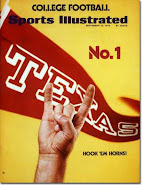
College Football, Texas No. 1, Hook 'em Horns, Sept. 10, 1973. Living in North Miami Beach in the '70's, my Sports Illustrated usually showed up in my mailbox on the Thursday or Friday before the Monday cover date. And was read cover-to-cover by Sunday morning.
The Perfect Storm
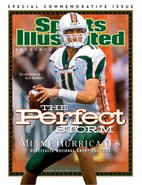
U-M QB Ken Dorsey, Miami Hurricanes Undefeated National Champions 2001, Jan. 2002
Miami's Romp in the Rose
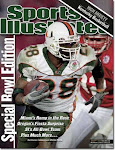
Miami running back Clinton Portis, Jan. 7, 2002
Why the University of Miami should drop football
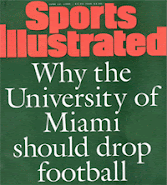
June 12, 1995
REVENGE!
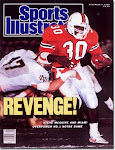
Steve McGuire and Miami Overpower No.1 Notre Dame, Dec. 4, 1989
How Sweet It Is!
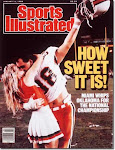
Miami Whips Oklahoma For The National Championship, Pictured: Dennis Kelleher, Jan. 11, 1988
My, Oh My, Miami!
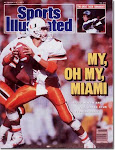
Steve Walsh and the Canes Stun FSU, Oct. 12, 1987
Why Is Miami No. 1?

QB Vinny Testaverde, Nov. 24, 1986
Miracle In Miami
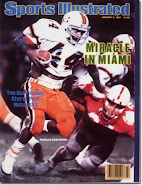
The Hurricanes Storm Past Nebraska, Halfback Keith Griffin, Jan. 9, 1984
Special Issue: College Football
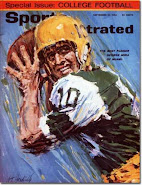
The Best Passer, George Mira of Miami, Sept. 23, 1963
1984 College & Pro Spectatcular
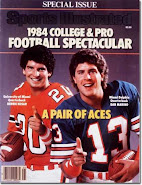
A Pair Of Aces: U-M QB Bernie Kosar & Miami Dolphin QB Dan Marino, Sept. 5, 1984
Pro Football Hall of Fame Special Issue

Dan Marino, Class of 2005, Aug. 2005
FACES OF THE NFL
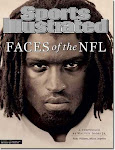
A Portfolio by Walter Iooss Jr., Ricky Williams, Miami Dolphins, Dec. 9, 2002
Coming Back
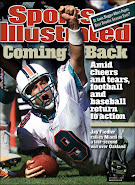
Jay Fiedler rallies Miami to a last-second win over Oakland, Oct. 1, 2001
Dan's Last Stand
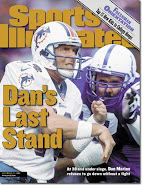
At 38 and under siege, Dan Marino refuses to go down without a fight, Dec. 13, 1999
The War Zone
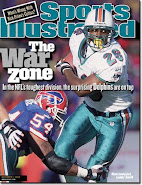
In the NFL's toughest division, the surprising Dolphins are on top, Lamar Smith, Dec. 11, 2000
Down and Dirty
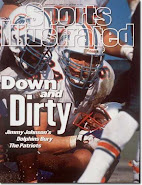
Jimmy Johnson's Dolphins Bury The Patriots, Steve Emtman, Sept. 9, 1996
The Sunshine Boys

Now Playing in Miami: The Dan Marino and Jimmy Johnson Show, May 11, 1996
HOT & NOT
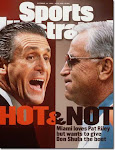
Miami loves Pat Riley but wants to give Don Shula the boot, Dec. 11, 1995
NFL PREVIEW 1995
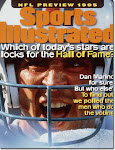
Which of today's stars are locks for the Hall of Fame? Dan Marino for sure. But who else? To find out, we polled the men who do the voting. Sept. 14, 1995
Sportsman Of The Year
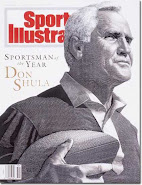
Don Shula, Dec. 20, 1993
Dan The Man
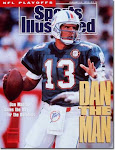
Dan Marino Saves The Day For The Dolphins, Jan. 14, 1991
Dangerous Dan
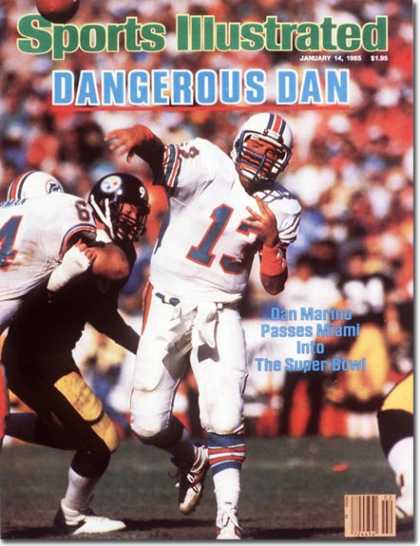
Dan Marino Passes Miami Into The Super Bowl, Jan. 14, 1985
Super Duper!

Wide Receiver Mark Duper Of The Undefeated Dolphins, Nov. 19, 1984
Air Raid! Miami Bombs Washington
+Sep+10,+1984.jpg)
Mark Clayton (burning Darryl Green) Sept. 10, 1984
Rookies On The Rise
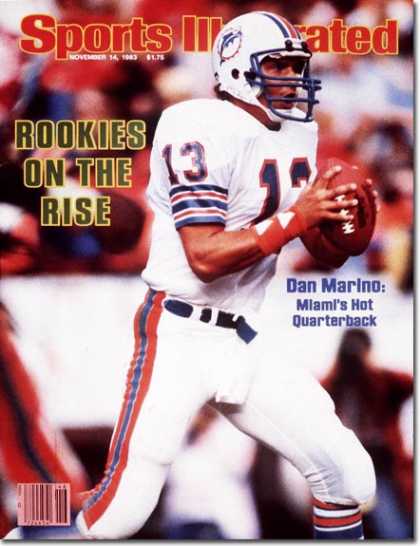
Dan Marino: Miami's Hot Quarterback, Nov. 14, 1983
New Life In The WFL
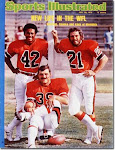
Warfield, Csonka and Kiick of Memphis, July 28, 1975
Zonk! Miami Massacres Minnesota
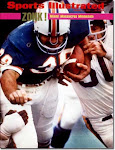
Larry Csonka, Jan. 21, 1974
Pro Football, Miami Is Rough And Ready

Larry Csonka & Bob Griese, Sept. 17, 1973
Miami All The Way
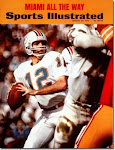
Bob Griese, Jan. 22, 1973
It's Miami and Washington
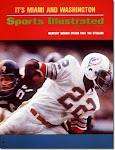
Mercury Morris Speeds Past The Steelers, Jan. 8, 1973
Kiick and Csonka, Miami's Dynamic Duo

Larry Csonka & Jim Kiick, Aug. 7, 1972
Sudden Death at Kansas City
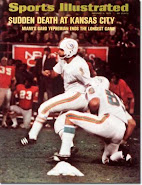
Miami's Garo Yepremian Ends the Longest Game; (kneeling) placekick holder Karl Noonan, Jan. 3, 1972
New Pro in a New Town

Miami's Frank Emanuel, Aug. 8, 1966
Old-style "Obie" the Orange Bowl Committee mascot

The iconic image I grew-up with in Miami, before FedEx got into the picture

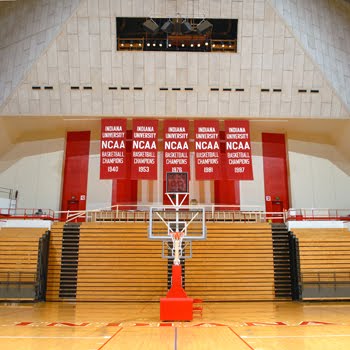

No comments:
Post a Comment